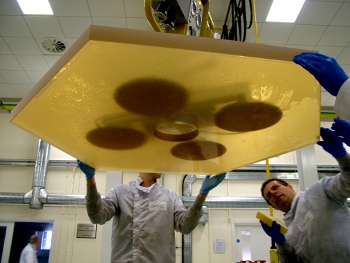Cranfield University has this week completed the grinding of mirror segments to be used for the European Extremely Large Telescope (E-ELT) – the largest optical telescope in the world.

Only two organisations worldwide have been contracted to grind these ultra-precise mirrors, with Cranfield the only one in the UK with the capability to do so. Cranfield has just completed its third mirror segment.
The mirrors must be ground to within a 20th of the size of a human hair. To do this a machine known as the ‘BoX’ (Big OptiX), which was designed specifically for the project and built at Cranfield, is being used. Its grinding abilities are significantly faster than those of its competitors, taking a matter of hours as opposed to days, with the capability to grind 100 segments per year.
On a recent visit to Cranfield, Professor Colin Cunningham, Director of the E-ELT programme, said: “This giant telescope provides considerable manufacturing challenges. It is great that through Cranfield we have the ability to make this telescope a reality. This is another big step forward to the exciting science breakthroughs we can expect in the next decade.”
The E-ELT is a ground-based telescope 39m in diameter and made up of 798 hexagonal segments, each 1.4m wide and just 5cm thick. At almost half the length of a soccer pitch in diameter, the E-ELT will gather 15 times more light than the largest optical telescopes operating today. It will allow astonomers to address many of the most pressing unsolved questions about our Universe, by enabling detailed studies of planets around other stars, the first galaxies in the Universe, super-massive black holes, and the nature of the Universe's dark sector.